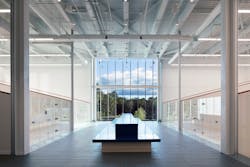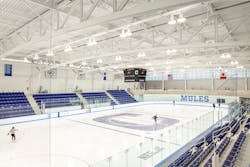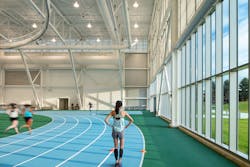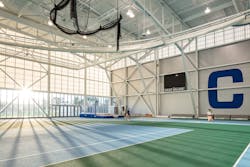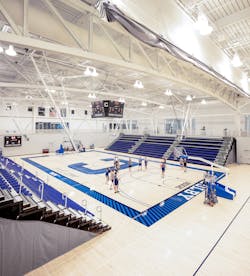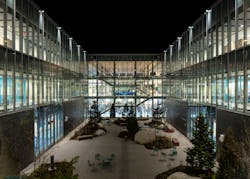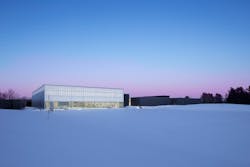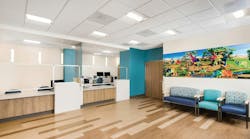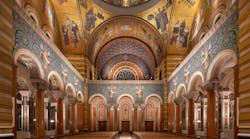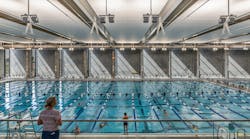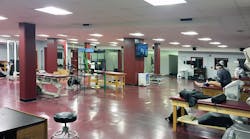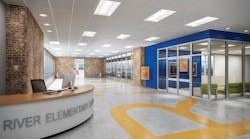HLB Lighting Design (HLBLD) has a long history of partnering with Boston-headquartered design and engineering firm Sasaki on lighting plans for recreation facilities. However, its collective collaboration with London-based Hopkins Architects on the luminous, $130 million-glass and gray brick-clad Colby College Harold Alfond Athletics and Recreation Center is arguably one of HLBLD’s most daring and innovative projects.
Designed to elevate the stature of the Division III athletics program for the college, located in Waterville, Maine, and to serve as a campus hub for student recreation and health and wellness, the 350,000-square-foot facility—the largest building project in the state at the time of its construction—is home to a long list of spaces and venues, including a multipurpose field house, an ice arena, a 50-meter pool, a competition gymnasium, squash courts, a fitness center, a climbing wall, locker rooms, offices, and sports medicine facilities.
In field houses and gymnasiums, says Robyn Goldstein, a Boston-based principal at HLBLD, bright, uniform illumination is essential to ensuring high-flying balls don’t get lost in the lights and players can safely navigate courts and tracks. Guided by that premise, HLBLD used simulation software by Ansys Government Initiatives (formerly known as AGI) to perform photometric calculations on all specified fixtures. Using data from manufacturer-supplied IES photometric files, which describe how light from a particular luminaire is distributed in rooms, these models generated image maps of each venue showing the optimal number and spacing of fixtures to ensure uniform light on playing surfaces and sufficient facial illumination. These calculations also helped the building achieve a 53% lower lighting power density than required by the ASHRAE 90.1-2010 building standard.
To keep lighting costs in check—roughly $7 per square foot, or $2.45 million for the entire project—the team specified throughout much of the project 28-inch diameter Holophane Phuzion LED high bays with impact-resistant lenses and protective wire caging. A total of 74 single and 140 twin Phuzion fixtures brighten the fieldhouse and ice arena. Mounted on stems and hangers suspended from the ceiling, the high bays are connected to passive heat exchangers and cast light through prismatic, frosted silicate glass lenses. About 16% of their total illumination is directed upward, a rarity for high bays and a pivotal part of the design strategy.
“With one fixture, we’re able to get two layers of lighting,” says Amy Huan, a senior associate at HLBLD. “That helped with both energy and budget, as well as visual comfort, because we’re able to apply a portion of the light to the ceilings, which helps especially in ball sports.”
Other program areas required more specialized lighting approaches.
Mounted on a custom-designed architectural truss system designed in collaboration with Sasaki, Quantum 12-inch diameter LED floodlights by Ligman Lighting in the natatorium are equipped with frosted glass lenses and a corrosion-resistant, anti-glare finish. The system is designed to protect swimmers from glare and withstand the conditions of the wet, chlorinated environment.
In the squash courts, where fixtures are especially prone to being struck by fast-moving balls, the team chose Kenall’s Millenium Stretch, an 8-inch-wide by 4-inch-tall domed linear luminaire protected by an extruded aluminum casing and a high-impact pearlescent polycarbonate lens.
While the building’s athletic areas had specific requirements, abundant natural light from the almost entirely transparent façade does much of the heavy lifting, Goldstein says. Over time, Lutron’s Quantum smart networked lighting control system, which is preconfigured to adjust light levels based on daylighting levels and preset scenes, is expected to lead to significant energy savings.
“The big part of the energy story is that [the building] is on a network control system," Goldstein says. The "fixtures dim or turn off when there’s a lot of daylight. In many ways, the lighting design is simple. But it creates a bold visual presence at the same time.”
Read more about the detailed lighting design of another sports and recreation project: Eastside Recreation Center, in El Paso, Texas.


